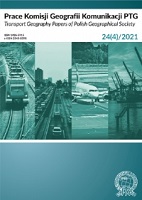Nowe sieci tramwajowe we Włoszech jako próba odpowiedzi na wyzwania transportowe w miastach
New tram networks in Italy as a response to transport challenges in cities
Author(s): Jakub TaczanowskiSubject(s): Policy, planning, forecast and speculation, Rural and urban sociology, Economic development, Transport / Logistics
Published by: Wydawnictwo Uniwersytetu Jagiellońskiego
Keywords: tram; light rail; public transport; cities; Italy;
Summary/Abstract: Italy, characterised by a very well developed polycentric urban network and being among the most motorised countries in Europe, has a very high potential for the development of new light rail systems. Although tram networks have never been completely dismantled there, the vast majority of them was closed after the Second World War. In 2003, the construction of new tram systems began. To date, eight networks have been built: in Bergamo, Cagliari, Florence, Messina, Padua, Palermo, Sassari and Venice with a total length of 101.8 km. The networks are rather short – only the systems in Venice, Palermo and Florence have more than 15 km of track. Both classic and fast tram as well as tram-train lines were built. Due to their rather short length and limited service of city centres, their impact on urban transport is mostly moderate. It should be stressed, however, that especially lines with a well-chosen route, connecting the city with satellite centres or crossing the entire city with a passage through the centre, are undoubtedly successful, attracting millions of passengers a year who used to use individual transport which results in an unquestionable benefit for the environment and traffic safety. Also the important role of new tram systems as catalysers of urban regeneration should be highlighted. It applies in particular to public spaces that are being given back to pedestrians and cyclists. Italy’s new tram systems are still in their infancy, so it is too early to evaluate their wider impact on modal share and motorisation rates across the city, let alone in the country. Nevertheless, the considerable potential of Italian cities for the further development of light rail systems is demonstrated by ambitious expansion plans for most existing networks, as well as the intention to implement completely new systems.
Journal: Prace Komisji Geografii Komunikacji PTG
- Issue Year: 24/2021
- Issue No: 4
- Page Range: 57-74
- Page Count: 18
- Language: Polish

